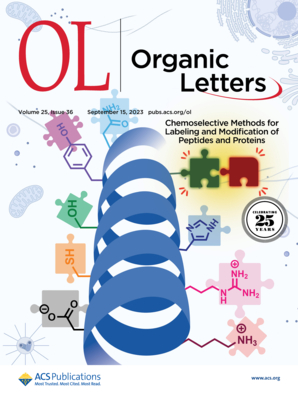Pd(II)/Cu(I) Co-catalyzed Dual C-H Functionalization of Indoles at C2 and C3 Positions Using Bifunctional Arylsulfonyl Reagents.
IF 4.9
1区 化学
Q1 CHEMISTRY, ORGANIC
引用次数: 0
Abstract
A Pd(II)/Cu(I) co-catalyzed dual C-H functionalization strategy enables the one-pot synthesis of C2/C3-difunctionalized indoles using arylsulfonyl reagents. In this method, Cu(I) reduces S(VI) reagents to generate arylsulfonyl radicals, which react with Pd(II) to form electrophilic Ar-Pd(III) intermediates. These intermediates regioselectively arylate indoles at the C2 position, followed by Cu(II)-mediated C-H functionalization at the C3 position, to deliver the final products. This synergistic method enhances efficiency, reduces waste, and streamlines complex indole functionalization.Pd(II)/Cu(I)用双功能芳基磺酰基试剂共催化吲哚在C2和C3位置的双碳氢功能化。
采用Pd(II)/Cu(I)共催化双C-H功能化策略,采用芳基磺酰基试剂一锅法合成了C2/ c3双功能化吲哚。在该方法中,Cu(I)还原S(VI)试剂生成芳基磺酰基自由基,与Pd(II)反应生成亲电的Ar-Pd(III)中间体。这些中间体在C2位置选择性地芳基化吲哚,然后在C3位置进行Cu(II)介导的C-H功能化,以传递最终产物。这种协同方法提高了效率,减少了浪费,并简化了复杂的吲哚功能化。
本文章由计算机程序翻译,如有差异,请以英文原文为准。
求助全文
约1分钟内获得全文
求助全文
来源期刊

Organic Letters
化学-有机化学
CiteScore
9.30
自引率
11.50%
发文量
1607
审稿时长
1.5 months
期刊介绍:
Organic Letters invites original reports of fundamental research in all branches of the theory and practice of organic, physical organic, organometallic,medicinal, and bioorganic chemistry. Organic Letters provides rapid disclosure of the key elements of significant studies that are of interest to a large portion of the organic community. In selecting manuscripts for publication, the Editors place emphasis on the originality, quality and wide interest of the work. Authors should provide enough background information to place the new disclosure in context and to justify the rapid publication format. Back-to-back Letters will be considered. Full details should be reserved for an Article, which should appear in due course.
 求助内容:
求助内容: 应助结果提醒方式:
应助结果提醒方式:


